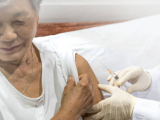May 28, 2010
Trial shows intradermal flu vaccine equal to adjuvanted version
In a head-to-head test of two seasonal influenza vaccine strategies to boost immune response in elderly patients, an intradermal version was as effective as an intramuscular vaccine with an immune-boosting adjuvant on most measures, researchers reported in BMC Infectious Diseases. Seasonal flu vaccines are effective in older people, but the immune response is lower than younger adults. The trial included 795 people ages 65 or older. Half received a dose of a 15-mcg antigen split-virus intradermal seasonal flu vaccine and half receive an intramuscular dose of a 15-mcg subunit counterpart that contained the adjuvant MF59C.1. The group assessed antibody titers with both hemagglutination inhibition (HI) and single radial hemolysis (SRH). The HI analysis showed that the intradermal vaccine performed just as well as the intramuscular shot for influenza A H1N1 and influenza B components of the vaccine, while SRH testing showed both vaccines were equally effective in protecting against all three strains. A covariance analysis that adjusted for baseline antibody titers showed that both were equally effective on both testing measures. Both vaccines were well tolerated, though mild, short injection-site reactions were more common with the intradermal vaccine.
May 26 BMC Infect Dis abstract
RNA treatment shows promise for Ebola infections
A trial of a postexposure treatment for Ebola infections funded by the US Department of Defense protected monkeys exposed to a dose of the Zaire Ebola strain, the most lethal form of the virus, researchers reported today in The Lancet. Currently there is no vaccine or treatment for highly contagious and often fatal Ebola virus infections. The treatment used in the trial consisted of three small interfering RNAs (siRNAs) designed to target the Zaire Ebola virus L polymerase protein, viral protein 24, and viral protein 35. The siRNAs were previously shown to be effective in a guinea pig trial. In the new study, three macaques were infected with the Zaire strain, then given the siRNA treatment after 30 minutes and 1, 3, and 5 days postchallenge. A group of four received a 7-day treatment: 30 minutes and on days 1 through 6. Two of the monkeys who received the 4-day regimen survived, and all who received the 7-day regimen survived. The 7-day treatment was well tolerated, with minor changes in liver enzymes that the researchers said could have resulted from the viral infection. They concluded that the siRNAs are a promising postexposure treatment for humans infected with the Ebola virus and that the strategy could be used to address other emerging viral threats.
May 29 Lancet abstract

















